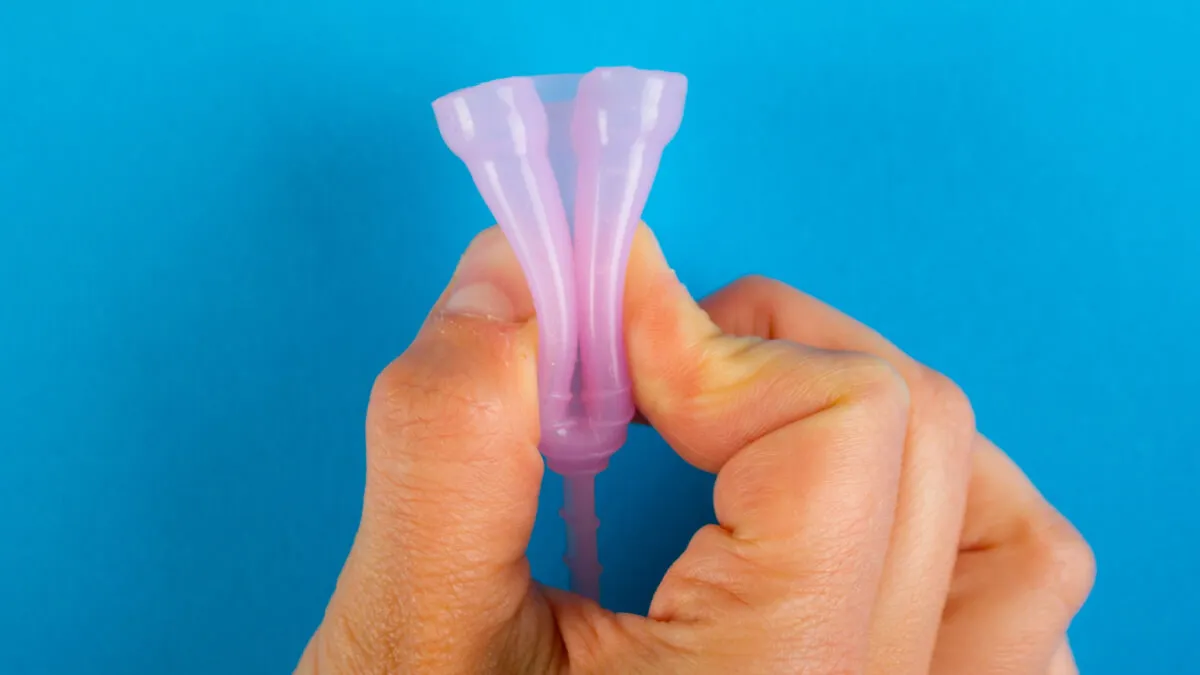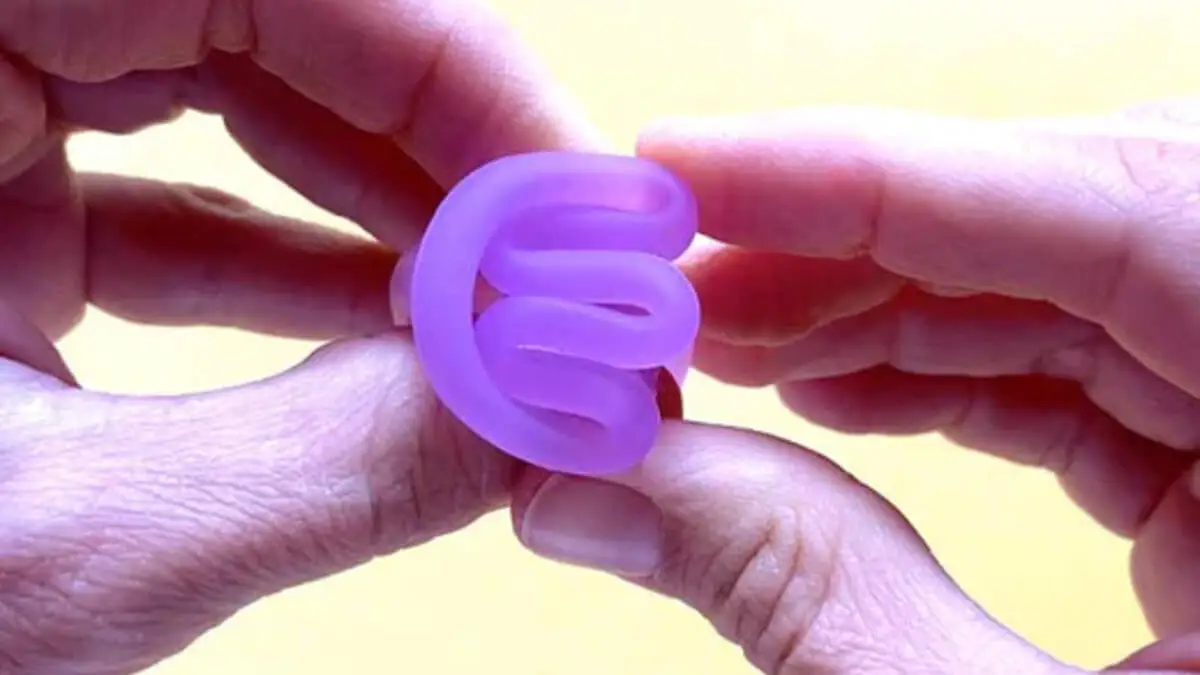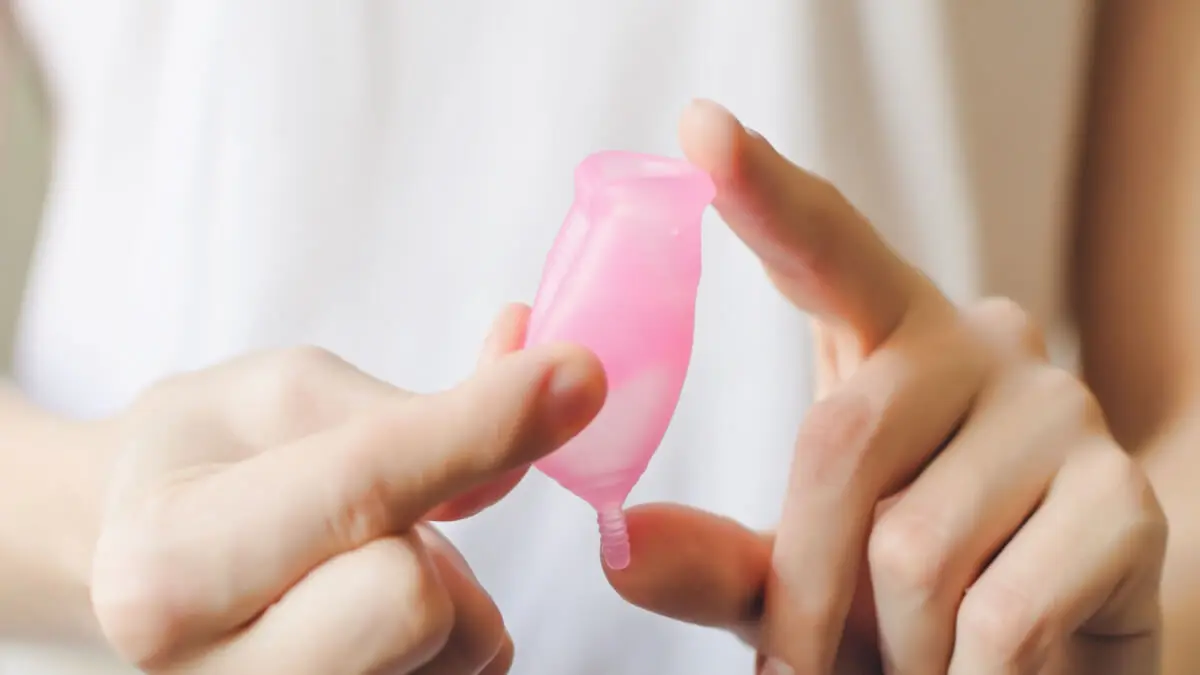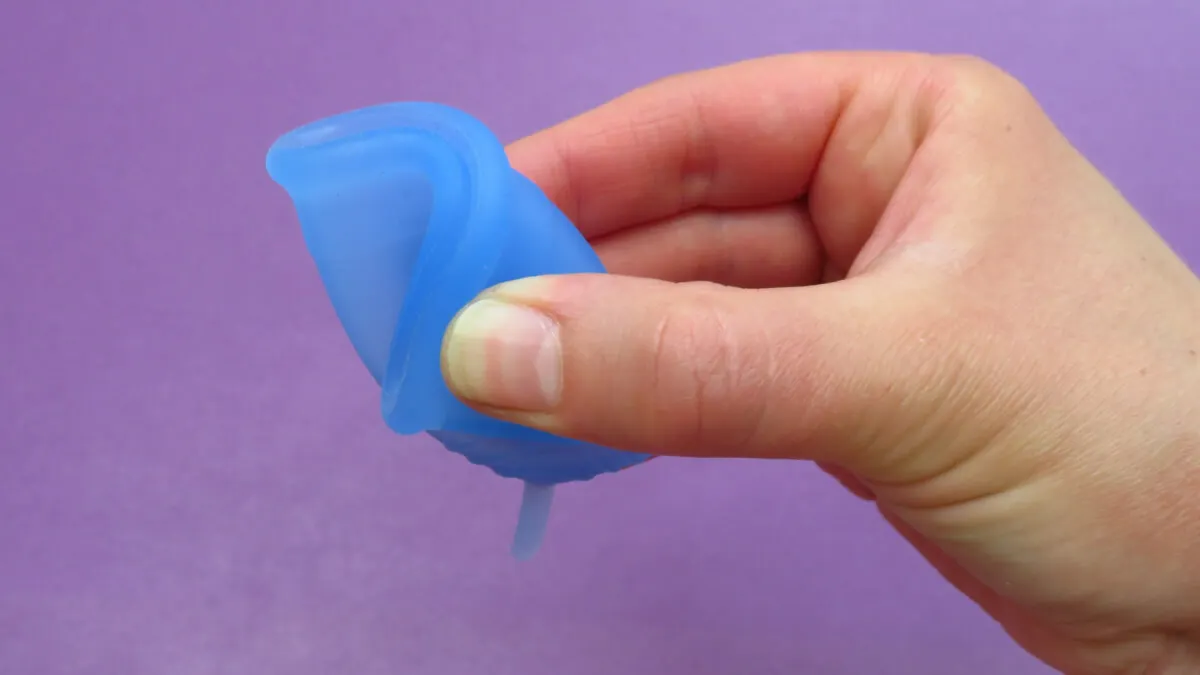How to Put In a Menstrual Cup Correctly The First Time


Written and verified by the dentist Vanesa Evangelina Buffa
In our search for eco-friendly and healthy alternatives, more and more women are opting for sustainable and budget-friendly menstrual protection options. However, doubts about how to put on the menstrual cup or fears of doing it wrong are some common reasons many women avoid using it.
Although it may sound difficult at first, with the right information and a little practice, using the menstrual cup can be an easy and simple experience for most women. We’ll tell you everything you need to know to use this product correctly from the first time.
How does the menstrual cup work?
The menstrual cup, unlike tampons and pads, is characterized by collecting menstrual blood instead of absorbing it. It’s made of medical-grade silicone and has a special design to fit the anatomy of your body.
It’s inserted inside your vagina until the stick or ball at the base is just flush with the labia. This ensures a comfortable and secure fit. In addition, its edges adapt to your body and generate a vacuum effect that prevents leakage.
Unlike traditional methods, which must be changed frequently, the menstrual cup can remain in place for several hours, depending on your menstrual flow. After a certain time, the cup is simply removed, emptied, cleaned, and reused.
With proper care, the menstrual cup can be reused for several years.
How to choose the right menstrual cup

To wear the menstrual cup correctly, it’s essential to have the right product. There are several brands, designs, and sizes on the market, so it’s important to consider certain criteria when selecting yours.
Choosing the right menstrual cup is critical to ensure a comfortable and effective experience during your menstrual period.
Choosing the right size menstrual cup will depend on several factors, including your age and whether you have had a vaginal delivery. As a general rule, if you’re under 30 and have never had a vaginal birth, size S is usually the best fit. Otherwise, you’ll probably need size L.
It’s important to note that the amount of menstrual flow doesn’t determine menstrual cup size. If you have heavy bleeding, you shouldn’t buy a larger cup, but will simply need to change it more frequently.
You may need to try several brands and designs until you find the texture and shape that is most comfortable for you. Remember that every body is different. If you have questions when choosing, consult a health professional for advice.
We think you may be interested in reading this, too: The Menstrual Disc: What Is It and How Does It Differ from the Menstrual Cup?
Menstrual cups and virginity
If you’ve never had sex, you can use a menstrual cup as a virgin. However, you may need a little extra practice and time to become familiar with your anatomy at first.
Virginity is a social and cultural construct that refers to not having had previous sexual intercourse. Using a menstrual cup doesn’t affect this status, since the cup is inserted into the vagina, but doesn’t involve sexual penetration.
As for the status of the hymen, an anatomical structure that in ancient times was used to determine whether a girl was a virgin or not, you should know that today it’s known that its shape and size vary in each woman. With everyday activities, the hymen tends to stretch and dilate. It may even have openings or be very flexible before a woman has sex for the first time.
Using a menstrual cup, like other daily activities, may exert a slight stretch on the hymen, but this doesn’t indicate a loss of virginity.
A step-by-step guide on how to properly insert your menstrual cup
Now that you have your menstrual cup, it’s time to use it. Follow this detailed step-by-step to do it right.
1. Sterilize your cup
Since you’re putting a product inside your body, to ensure your health and safety, it must be clean and germ-free. Never insert a menstrual cup without first sterilizing it.
The most effective way to clean and sterilize your menstrual cup is to soak it in boiling water for three to five minutes. This step removes bacteria and dirt, ensuring that it’s ready for safe use.
Some commercial brands include a sterilization kit when you buy your menstrual cup. This is a collapsible container that can be placed in the microwave for a few seconds.
During your menstrual cycle, it will not be necessary to re-sterilize the cup, just clean it with water and reinsert it. You’ll only need to repeat the sterilization process the following month, in your next cycle, before using the cup for the first time during that period.
2. Wash your hands
Because the cup will come in direct contact with your skin and vaginal mucous membranes, you must always wash your hands with soap before handling it. This way you will avoid introducing germs or bacteria that could cause vaginal infections.
If you have long fingernails or porcelain nails, it’s important to make sure they are clean and take special care not to pinch yourself during insertion or removal.
3. Find a comfortable position
When it comes to inserting your menstrual cup, you should find a position that feels comfortable and makes insertion easier. Try different positions until you find the one that works best for you: lying on the bed, squatting on the floor, or with one foot resting on the edge of the bathtub can be helpful.
For the first time, you can choose to place your cup in the shower or bathtub. This will allow you to relax, spread your legs as wide as you need to, and eliminate any worries about staining anything.
Once you become familiar with the process, you will certainly feel more comfortable and confident to place your menstrual cup anywhere, anytime.
4. Fold the cup
When you see the cup unfolded, it may seem impossible for it to fit inside your vagina. However, the key is to fold it before insertion.
There are different ways to fold the menstrual cup and you will need to find the right one for you. We explain different types of folds so you can choose the one that works best for your body.
The Flower or “C” fold

This is one of the simplest and easiest folds to make. Flatten the cup and fold it in half to form a sort of “C” or “U” shape. This fold is ideal for beginners since it’s a smooth fold and opens easily once inserted.
The “Punch down” fold

If you’re having problems getting the cup to open completely once inserted, the “punch down” fold may be the solution.
To do this, hold the cup in one hand and use the index finger of the other hand to push one of the edges inward, forming a sort of fist towards the inside of the cup. This fold will open once it’s inside the vagina.
The “S” fold
Bring the edges of the cup together to close it and then, holding them together, push the two sides in opposite directions to create an “S” shape.
The “E” shape fold

For this fold, bring the edges of the cup together and fold it in half to form a “C” shape. Then take one of the ends from the center outward to form the shape of an “E” or “M”.
The triangular fold

Pinch the edge of the cup to flatten it. Then, once closed, pull one end of the rim diagonally across the opposite side to form a tight triangle.
The “7” fold

Similar to the triangle fold, but the cup is less closed. Flatten the cup by squeezing the edge. Once closed, bring one end of the rim diagonally toward the opposite side of the cup, but not all the way to the tip, thus forming the number “7”.
The diamond fold

Pinch the center of the cup to close it, then pull the rim of one side open over the center, forming an “O”. Next, bring the opposite sides of the “O” to overlap and form a diamond.
The Origami fold

Push the rim of the cup halfway inside. Then, fold one corner diagonally covering the previous fold.
5. Insert the cup
Once you have chosen the desired fold and prepared your menstrual cup, it’s time to insert it. To do this, take a deep breath, separate the labia with one hand, and with the other hand slowly and gently insert the cup into your vagina.
Follow a slight orientation towards your spine. The cup should sit inside the vagina, but not too far in, just enough so that the bottom ball is flush with the labia.
If you’re used to using tampons, you should know that the cup doesn’t sit as high up as these products. Most of the time you will only have to insert a little bit of your fingers to insert it.
Hold the base of the cup firmly while inserting it to prevent it from opening too soon. Once inserted, it should open automatically.
To make inserting the cup more comfortable, you can use a water-based lubricant to help. You can also wet the cup or insert it while showering.
Like this article? You may also like to read: Did You Know a Woman’s Voice Changes During the Menstrual Cycle?
6. Check the seal
To make sure your cup is seated properly, touch the base of the cup and make sure it’s rounded all the way around. Also try rotating it 360 degrees, like a thread: a properly seated menstrual cup will rotate in all directions.
If you feel any discomfort, try tilting the cup toward your tailbone and gently squeeze the base to help it open fully.
Other tips for successful menstrual cup insertion
In addition to the menstrual cup insertion steps we’ve already told you about, here are some additional tips to help you have a more comfortable and successful experience:
- Relax and take your time: Choose a quiet, undistracted time to insert or remove your menstrual cup. If you’re nervous, your vaginal muscles may tighten, making successful insertion difficult.
- Familiarize yourself with your body: Know your anatomy so you know where to insert the cup. Locate the vaginal opening and, if necessary, insert a finger to find your cervix. Knowing where it’s located will help you place the cup where it should be and avoid inserting it too high.
- Practice during your period: Your vagina is more flexible during menstruation and blood can act as a lubricant. Take advantage of these days to practice inserting and removing the menstrual cup and familiarize yourself with the process.
- Be patient: It’s normal to need several attempts before you feel comfortable using the menstrual cup. Don’t get frustrated if you don’t succeed right away. With practice and patience, you will improve your technique.
- Check the stem: Once the cup is inserted, evaluate whether you need to hold the stem. If it sticks out too far and is uncomfortable, you can trim it as needed. However, if it doesn’t bother you, it may be useful to help you with removal.
Remember that menstrual cup insertion and removal should never be painful. If you feel discomfort at any stage, stop, relax, and try again later when you are more relaxed.
When should you empty the menstrual cup?
Now that you know how to insert your menstrual cup, new questions arise: When to take it out? Can it get stuck in there? How do I remove it?
Relax! Removing the menstrual cup also has its tricks, but it always comes out and is quite simple.
The time to remove your cup will depend on the amount of your menstrual flow. At first, you can empty it every 4 hours. Never use it for more than 12 hours at a time to avoid the risk of infection.
When you remove it, flush it down the toilet and then wash it with soap and water, taking care to rinse it thoroughly. At the end, you can reinsert it to continue using it.
How to remove it
The first few times, to remove the menstrual cup and avoid stains, try removing it in the shower or bathtub. This will help you to be more relaxed and not be worried about spilling the contents. You can do this standing, squatting, or sitting.
To remove it, take a deep breath to relax. Then gently squeeze the bottom of the glass and move it to the side, to break the vacuum that has been created. The idea is to move one edge of the cup away from the vaginal wall to release the suction.
You can also achieve this effect by inserting your index finger from the side, between the cup and the vaginal wall, and pressing toward the center. If you also press your pelvic floor muscles downward, using force like when you urinate, you can help release the cup.
Once you have released the suction, gently rock the cup back and forth as you pull it down and out. Avoid pulling on the lower stem or ball to remove the cup, as this may cause discomfort.
How to clean and store your menstrual cup
To take care of your menstrual cup and, at the same time, your health, it’s important that you take care to keep the product clean and in optimal condition.
At the end of your period, wash your menstrual cup with cold water and mild soap to remove blood residue. Avoid using soaps with fragrances or harsh chemicals, as they can damage the silicone. To finish, rinse well and dry with a clean towel or air dry.
Store your menstrual cup in a clean, dry place when not in use. Use the bag provided by the manufacturer or an air-permeable container. Avoid storing the cup in airtight containers or plastic bags that do not allow air circulation, as this can promote bacterial growth.
Before each use, inspect your menstrual cup for cracks, tears, or other signs of deterioration. If you find any damage, you may want to replace it.
Sex and menstrual cups: What you should know
Compatibility between sex and menstruation, especially if you use a menstrual cup, is a common question among women. However, the decision regarding whether or not to have sex during your period depends on you and your partner’s comfort.
Sex during menstruation is safe and natural. During this time, the endometrium sheds and is expelled from the body. In some women, this causes irritation, inflammation, and menstrual cramps. On the other hand, others experience an increase in sexual desire and an easier time reaching orgasm.
It’s important to note that vaginal penetration is not possible while you are wearing a menstrual cup. If you insert anything besides the cup, you will displace it at the end of the vaginal canal, putting pressure against the cervix. This may cause some damage and complicate the process of locating and removing the cup.
If you wish to have sex while using your menstrual cup, you can explore other forms of non-penetrative intimacy, such as masturbation, oral sex, anal sex, fondling, and erotic massage. The cup facilitates these experiences by eliminating concerns about staining when you move.
It’s possible to have sex with your menstrual cup in, but vaginal penetration is not possible.
If you decide to remove your cup before having sex, be sure to empty and wash it before doing so. The shower is an ideal place to have sex during menstruation, as it’s more hygienic and comfortable.
Finally, it’s always a good idea to use condoms to prevent sexually transmitted infections and unwanted pregnancies. Remember that menstruation is not a method of protection in these situations.
Like this article? You may also like to read: What is Menstrual Fatigue and How Can You Deal With It?
You can with the cup!
The menstrual cup has revolutionized the way women experience their menstrual periods. More than a feminine hygiene product, this method is a conscious and environmentally friendly alternative, in addition to providing you with comfort and freedom during those days of the month.
If you have chosen to use it, remember that every body is different, so take your time to find the technique that works best for you and remember that if you have doubts about its use and which one works best for you, do not hesitate to go to your gynecologist. Soon you will feel safe and confident using your menstrual cup!
All cited sources were thoroughly reviewed by our team to ensure their quality, reliability, currency, and validity. The bibliography of this article was considered reliable and of academic or scientific accuracy.
- Arenas, C., Ramírez, G., González, L., & Rueda, S. (2020). Acceptability and safety of the menstrual cup: A systematic review of the literature. Revista colombiana de obstetricia y ginecologia, 71(2), 163-177. http://www.scielo.org.co/
- Fahs, B. (2020). Sex during menstruation: Race, sexual identity, and women’s accounts of pleasure and disgust. The Palgrave Handbook of Critical Menstruation Studies, 961-984. https://www.researchgate.net/profile/
- Kakani, C. R., & Bhatt, J. K. (2017). Study of adaptability and efficacy of menstrual cup in managing menstrual health and hygiene. International Journal of Reproduction, Contraception, Obstetrics and Gynecology, 6(7), 3045-3054. https://www.researchgate.net/
- Moussaoui, D., Abdulcadir, J., & Yaron, M. (2022). Hymen and virginity: What every paediatrician should know. Journal of Paediatrics and Child Health, 58(3), 382-387. https://onlinelibrary.wiley.com/doi/abs/10.1111/jpc.15887
- Van Eijk, A. M., Zulaika, G., Lenchner, M., Mason, L., Sivakami, M., Nyothach, E., & Phillips-Howard, P. A. (2019). Menstrual cup use, leakage, acceptability, safety, and availability: a systematic review and meta-analysis. The lancet public health, 4(8), e376-e393. https://www.thelancet.com/journals
This text is provided for informational purposes only and does not replace consultation with a professional. If in doubt, consult your specialist.








